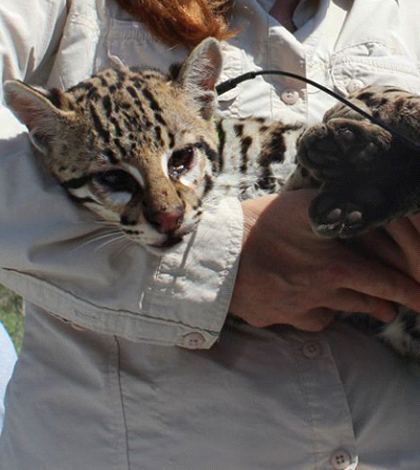Rare good news for endangered ocelots in Texas

The United States’ endangered ocelots have received some rare good news. As Stacy Johnson reported from Valley Central KGBT Action 4 News of the Rio Grande Valley, a well known conservationist and rancher has set aside 7,428 acres in South Texas for the endangered cats, whose wild population is under 50 in the U.S.
A long-time admirer of the cats, Frank Yturria made history in 1989 when he became the first landowner in the U.S. to set aside land — 500 acres — for the ocelot. As Yturria says in the KGBT news story, “(The ocelot) is just such a lovely, beautiful little cat. You very rarely see him. But occasionally, late in the afternoon, one may run across the road, and when it does you get a little excited. You say, ‘Look, there is something that was about to disappear in the country, but it is still here. Let’s protect it.’”
Asher Price of the Statesman recently reported another good piece of news for the ocelots: They will soon get a new set of highway crossings. The crossings will hopefully prevent vehicle strikes, which are the most common cause of death for the cats. The Texas Department of Transportation plans to create the crossings after several ocelots leapt concrete barriers designed to protect motorists along a dangerous stretch of road in the ocelot’s range in South Texas. The ocelots could not see what was on the other side of the barrier and, after leaping, would not be prepared for oncoming traffic, causing collisions fatal to the cats.
According to The Nature Conservancy, the loss of even one ocelot is serious, with such a small remaining population. The South Texas ocelots are the only breeding population in the U.S. They continue to be monitored extensively by the U.S. Fish and Wildlife Service. The wildlife cameras and radio collars used by the agency to track the cats help managers plan conservation measures, including the location of wildlife crossings.

A U.S. Fish and Wildlife Service wildlife camera picked up this image of an ocelot kitten in March 2014. (Credit: U.S. FWS)
One of the Fish and Wildlife Service’s cameras provided a little more hope for the species in March 2014 when it captured images of an ocelot kitten in the Laguna Atascosa National Wildlife Refuge. The apparently healthy kitten could be especially beneficial if it’s a female, as the species’ every-other-year birthing pattern is a significant limit on population growth.
Top image: The U.S. Fish and Wildlife captured this young female ocelot and gave it a radio tracking collar before releasing it in the Laguna Atascosa National Wildlife Refuge. (Credit: U.S. FWS)




0 comments